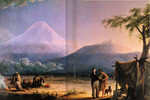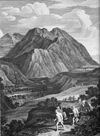| Meeting 17 • 06 March 2012 • Tuesday |
Version: |
|
pictures of the week |
thought-bite of the week: |
|
|
"'I knew,' said the young Indian girl coolly, 'that the crododile would let go when I stuck my fingers in its eyes.'" |
|
mini-text of the week: "'…but the zambo would expect to be treated as an equal, and that I cannot do with a man of his colour.'" Humboldt, "Personal Narrative", from Jaguars and Electric Eels, ed. & trans. Wilson, pp. 47 (read more) |
|
(X') = anticipated time in minutes (total=75) |
(0001) etc.=item in Humboldt Project document collection |
|
Key to notes added AFTER the class meets: |
|
|
√ = topic / activity that was adequately dealt with during the class |
+ = topic that was started but needs more attention & will be resumed at next / subsequent meeting(s) |
|
- = a topic / activity that was proposed though not begun, but will be taken up later |
|
|
Italic bold green text like this = comments after the meeting |
|
|
√ |
(10') Thought-bite of the week: The Indian girl - what other encounters with indigenous people, as individuals, are recorded in Jaguars and Electric Eels or in the Helferich biography? How does AvH portray the "non-indigenous" (but sometimes long-resident) people(s)? Followup on previous meeting's music (Gottschalk): NPR broadcast (5 March 2012, ca 7:45 am) about "zumba" exercise vs. "true" salsa, and "true" yoga vs. "phony" yoga: What does it mean when cultures borrow from each other? For now just the question - we'll get back to it during the rest of the course. |
|
+ |
(15') More about triangulation. Congruent triangles to measure distance over inconvenient territory. The Great Trigonometric Survey of India (Mt. Everest! - but remember the cargueros and sherpas). Thedolite and trigonometric tables to measure altitude (importance of "tangent" useful learning resource - and also a YouTube example of calculating height/altitude - may get on your nerves). Sextants and earlier navigational tools. Here are directions about getting smart phone apps for the course. For iPhone (all free of charge): "Thedolite", "Elevation", "Trig Solver" (actually does just triangles, but that's what we want), and maybe (advanced users:) "Spyglass". The same or similar apps exist for Android. |
|
+ |
(20') Group projects: Map out the Big Idea/Picture; drill down to representative examples; relate to stakeholders (learners, schools, teachers, communities); map onto educational standards; remember learning styles and strategies Species descriptions: Don't write for yourself, don't write for me, don't write for the scientists; Transform! Involve the learners in the learning. Look at lesson plans and other sources of writing for specific audiences. Value of hands-on learning in math: Why, indeed, is the area of a circle calculated by squaring its radius and multiplying that by pi? A demonstration of hands-on math learning. |
|
√ |
(10') The world Now and in 1600 (-1900+): standards of living for the (decile) range of population; What caused the change, and what did the change cause? How does that relate to social responsibility (activism?) and sustainable environmentalism? See also handout from previous meeting: pictures from Lesy, Wisconsin Death Trip; article from The Economist, about malnutrition in the present. |
|
+ |
(15') More about trust and sources of info: Survey: Where do you get your own information, opinions, conclusions, solutions, and how do you check it out? What can the educated citizen read? (periodical press; local, quotidien; long-term knowledge). How do educated citizens become capable writers? (See above: what do educated citizens read? For specific example of a text at the "educated citizen" level, see the handout distributed at the previous meeting, "The nutrition puzzle," The Economist, February 18th, 2012, pp. 82-3) |
|
(5') Checkups & Previews: Example of a reading selection ("Climbing the Redwoods") like the one you will read in preparation for the final exam. We'll discuss it at the next meeting. These final two weeks: Humboldt's influence on the development of systems of land and water measurement and management in the US. Reminder: Keep your meeting handouts - maybe punch them and put them in a binder. You can also print the meeting notes from the links to the meetings on the schedule page of the course website. Where a handout includes extra material added to the printout of the meeting's web page, you'll see an additional link ("sup |

